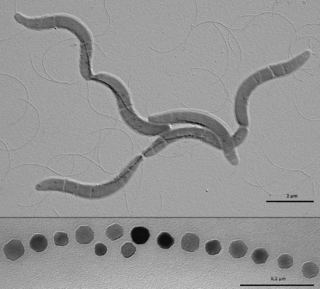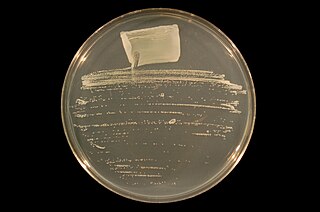Related Research Articles

The Rhodospirillales are an order of Proteobacteria.
The Aurantimonadaceae are a small family of marine bacteria.

Alphaproteobacteria is a class of bacteria in the phylum Proteobacteria. The Magnetococcales and Mariprofundales are considered basal or sister to the Alphaproteobacteria. The Alphaproteobacteria are highly diverse and possess few commonalities, but nevertheless share a common ancestor. Like all Proteobacteria, its members are gram-negative and some of its intracellular parasitic members lack peptidoglycan and are consequently gram variable.
In taxonomy, the Acidilobales are an order of the Thermoprotei.

Ensifer is a genus of nitrogen-fixing bacteria (rhizobia), three of which have been sequenced.
Rhodopseudomonas is a genus of bacteria from the family Nitrobacteraceae.

Bacterial phyla constitute the major lineages of the domain Bacteria. While the exact definition of a bacterial phylum is debated, a popular definition is that a bacterial phylum is a monophyletic lineage of bacteria whose 16S rRNA genes share a pairwise sequence identity of ~75% or less with those of the members of other bacterial phyla.
The Sphingomonadales are an order of the Alphaproteobacteria.
Hoeflea is a genus of Gram-negative, strictly aerobic, oxidase- and catalase-positive, non-spore-forming, rod-shaped bacteria.
Phyllobacterium is a genus of Gram-negative, oxidase- and catalase-positive, aerobic bacteria.
Hyphomicrobium is a genus of Gram-negative, non-spore-forming, rod-shaped bacteria from the family of Hyphomicrobiaceae. It has a large polar or sub-polar filiform prostheca very similar to that of Caulobacter. In addition to having a nutritional function, the prostheca also plays a role in the initiation of DNA replication.
Neomegalonema is a genus of bacteria. Up to now there is only one species of this genus known.
Erythrobacteraceae is a bacterium family in the order of Sphingomonadales.
Pleomorphomonas diazotrophica is a Gram-negative, aerobic, pleomorphic and nitrogen-fixing bacterium species from the genus Pleomorphomonas which has been isolated from root tissue of the plant Jatropha curcas at the agrotechnology experimental station in Singapore.
Pleomorphomonas koreensis is a Gram-negative, aerobic, nitrogen-fixing, non-spore-forming rod-shaped and non-motile bacterium species from the genus of Pleomorphomonas which has been isolated from soil in Daejeon in Korea.
Pleomorphomonas oryzae is a nitrogen-fixing bacterium species from the genus of Pleomorphomonas which has been isolated from the rice plant Oryza sativa in Japan.
Nitrospinota is a bacterial phylum. Despite only few described species, members of this phylum are major nitrite-oxidizing bacteria in surface waters in oceans. By oxidation of nitrite to nitrate they are important in the process of nitrification in marine environments.
Devosiaceae is a family of Alphaproteobacteria.
Pleomorphomonadaceae is a family of Alphaproteobacteria.
References
- 1 2 Xie, CH; Yokota, A (2005). "Pleomorphomonas oryzae gen. nov., sp. nov., a nitrogen-fixing bacterium isolated from paddy soil of Oryza sativa". International Journal of Systematic and Evolutionary Microbiology. 55 (Pt 3): 1233–7. doi: 10.1099/ijs.0.63406-0 . PMID 15879261.
- 1 2 LPSN
- 1 2 "Pleomorphomonas".
- ↑ Hördt, Anton; López, Marina García; Meier-Kolthoff, Jan P.; Schleuning, Marcel; Weinhold, Lisa-Maria; Tindall, Brian J.; Gronow, Sabine; Kyrpides, Nikos C.; Woyke, Tanja; Göker, Markus (7 April 2020). "Analysis of 1,000+ Type-Strain Genomes Substantially Improves Taxonomic Classification of Alphaproteobacteria". Frontiers in Microbiology. 11: 468. doi: 10.3389/fmicb.2020.00468 . PMC 7179689 . PMID 32373076.